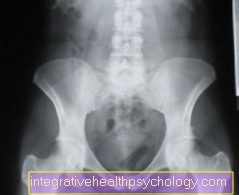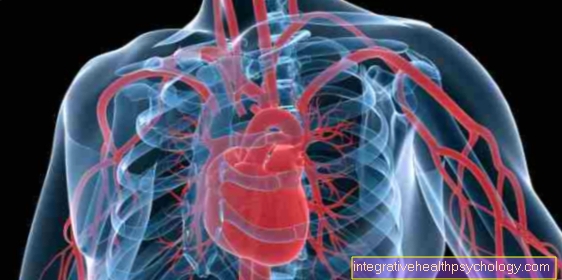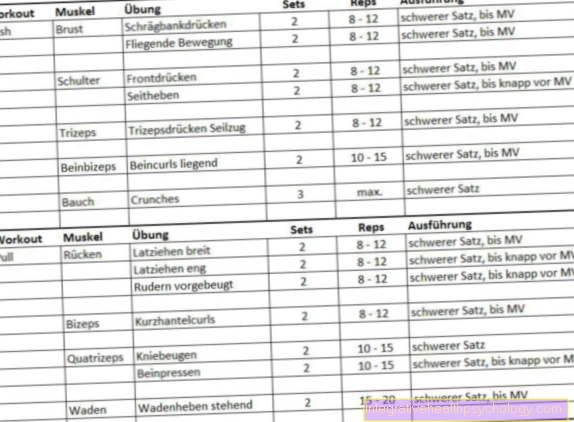Funicular myelosis
definition
Triggered by a chronic vitamin B12 deficiency, funicular myelosis causes regression of certain areas of the spinal cord.

Symptoms
The funicular myelosis is noticeable through a breakdown of the myelin sheaths that surround the nerves (so-called demyelinating). If this sheathing of the nerve cells is missing, malfunctions and short circuits occur in the transmission of nerve impulses and stimuli.
In funicular myelosis, the posterior cords and the pyramidal lateral cords of the spinal cord are particularly badly affected. Here information from the sensory organs is passed on to the brain. A malfunction such as funicular myelosis leads to an unsteady gait and the resulting dizziness, as the body can no longer orientate itself correctly in space (impaired depth sensitivity). In addition, the patients suffer from paresthesia and pain, especially in the legs.
In addition, there is a rapid fatigue when walking, burning tongue and impotence, as well as urinary retention. If the optic nerve or the nerve tract of vision is also affected, this can lead to visual disturbances. Mostly, funicular myelosis occurs in patients around the age of 45.
Muscle twitching in funicular myelosis
Muscle twitching is not a typical or specific symptom of funicular myelosis, but it can occur. The reason for this is on the one hand the increased self-reflexes. Even minimal touches or movements that would have no further consequences for a healthy person can trigger reflexes and thus muscle twitches. Spastic paralysis can also develop, which can initially appear as muscle twitching.
On the other hand, the muscle twitching can appear as a sign of a loss of position sense (proprioception). If the sense of position is disturbed, one is no longer able to position and posture with closed eyes, e.g. of the arm. The body's sense of self is missing. Compensatory movements in the form of muscle twitching can occur.
For detailed information on this topic, see: Muscle twitching
causes
The cause of funicular myelosis is the chronic deficiency of vitamin B12. In order to absorb the vitamin in the intestine, the body produces the so-called intrinsic factor in the stomach, so that in stomach diseases there may be a malfunction of the vitamin B12 absorption if the production of the intrinsic factor is disturbed. Deficiency is pernicious anemia.
Severe damage to the gastric mucosa can occur in the case of chronic inflammation of the gastric mucosa (chronic atrophic gastritis), a malignant stomach tumor (gastric cancer; stomach cancer) or alcoholism. If the stomach was surgically removed, for example because of a stomach tumor, the gastric mucosa and thus the intrinsic factor formed there is completely missing There is no longer enough vitamin B12 available for your own metabolism.
There is also an increased need for vitamin B12 during pregnancy and with various cancers such as leukemia or myeloma. If there is a pathological bacterial colonization in the patient's intestine, this can also lead to a vitamin B12 deficiency.
An unbalanced diet and starvation can also lead to an undersupply of vitamin B12.
The absorption of vitamin B12 can be negatively influenced by several intestinal diseases. These include, for example, Crohn's disease and sprue (in adults), as well as celiac disease (in children) and the chronic dysfunction of the pancreas (chronic pancreatic insufficiency after inflammation or a similar disease).
If part of the patient's intestine has been removed, this can also lead to a reduced absorption of vitamin B12. Some medications, for example anti-epileptics as well as cytostatics, can have a negative effect on the vitamin B12 metabolism.
There are also drugs that inhibit vitamin B12 absorption in the ileum. Particularly noteworthy in this context are proton pump inhibitors and the antidiabetic drug metformin, as these are drugs that are taken very frequently and are often even regularly prescribed in combination. This may result in a serious vitamin B12 deficiency with symptoms of funicular myelosis, which can be misdiagnosed as diabetic polyneuropathy, especially in affected diabetics. The actual cause of the polyneuropathy is consequently not treated, although simple administration of vitamin B12 (intravenous or oral) could remedy the symptoms.
There is a depot of vitamin B12 available in the liver of humans, so deficiency symptoms only appear after about 3 years of impairment of vitamin B12 absorption.
Vitamin B12 deficiency in funicular myelosis
The vital vitamin can only be produced by bacteria and is naturally present in animal products such as meat, poultry, fish, mussels, seafood and, to a lesser extent, in milk. In yeast or plant products there is generally no such thing as a requirement for vegans or vegetarians to take vitamin B12 as a dietary supplement. People who are over 50 years old should also consume additional vitamin B12 to fully meet their needs.
Please also read: Vitamin B12 deficiency
Alcohol as a cause of funicular myelosis
With chronic alcohol abuse, a vitamin B12 deficiency is more likely to occur, which in turn can lead to funicular myelosis. The vitamin B12 deficiency occurs on the one hand as a result of chronic inflammation of the gastric mucosa, which is very common in alcoholics. The gastric mucosa can no longer produce the substance (intrinsic factor) that is necessary for the absorption of the vitamin, which is why vitamin B12 can no longer be absorbed.
On the other hand, chronic alcoholics often no longer have a balanced, healthy diet and do not get enough vitamin B12 from the outside. A vitamin B12 deficiency can also result from alcoholism.
These articles might also interest you:
- Consequences of alcohol
- Effects of alcohol on the various organs of the body
- Alcohol addiction
Diagnosis
The following features of funicular myelosis are particularly noticeable during the physical examination:
- pale yellow skin
- Yellowing of the whites of the eyes (sclera)
- Hunter glossitis (regression of the lining of the tongue) with red, burning tongue
- Sensory disorders in legs and feet
- Muscle weakness in legs and feet
- Unsteadiness
- positive Romberg sign
- pathologically altered reflexes
- weakened or absent self-reflexes
- greatly reduced vibration sensation
- greatly reduced position sensitivity
- Delusions
- Dementia symptoms
- depressive moods
If you also examine the water in the spinal canal (liquor), two thirds of the affected patients notice an increase in protein.
The measurement of the nerve conduction velocity (electroneurography) shows a slowdown in about three quarters of the patients, which is partly due to a simultaneous polyneuropathy.
If the blood is examined, a megalocytic hyperchromic anemia (certain form of anemia), as well as a partial destruction of the red blood cells and a decrease in the white blood cells can be determined.
The reduction in the vitamin B12 concentration in the blood must also be measured. The so-called Schilling test can be used to diagnose an uptake of vitamin B12 in the small intestine.
What do you see on the MRI for funicular myelosis?
Diagnostic imaging in the form of magnetic resonance imaging (MRI) is not always necessary, but it can confirm the diagnosis. An MRI is particularly popular with atypical symptoms that do not clearly match a funicular myelosis. The MRI examination shows damage mainly in the area of the posterior cords of the spinal cord and in the area around the cerebral chambers (area of the subcortical, periventricular medullary bed). The posterior cord of the spinal cord can also be affected.
The affected structures are responsible in particular for aspects of the sense of touch and for the body's perception in space (proprioception). The symptoms are explained by the damage there. The MRI image is recorded using the so-called T2 weighting technique, in which cerebrospinal fluid and swollen tissue are shown brightly. Accordingly, bright spots can be seen in the mentioned areas of the spinal cord. The rest of the spinal cord is dark.
therapy
The funicular myelosis will by administering vitamin B12 as an injection or infusion treated. This substitution is sometimes for years may be necessary until the actual cause of the reduced vitamin B12 content in the body can be eliminated.
forecast
The prognosis of funicular myelosis is very good and a complete cure is possible if the clinical picture or the triggering vitamin B12 deficiency is recognized in good time. If funicular myelosis is diagnosed within three months and immediately treated with vitamin B12, the blood cells return to normal within a very short time. The encephalopathy, i.e. the actual damage to the brain, regresses after a few weeks. The neurological symptoms and failures can still occur for a few months.
If the funicular myelosis is recognized and treated later, parts of the encephalopathy and / or neurological symptoms can remain and remain for the rest of life.





























